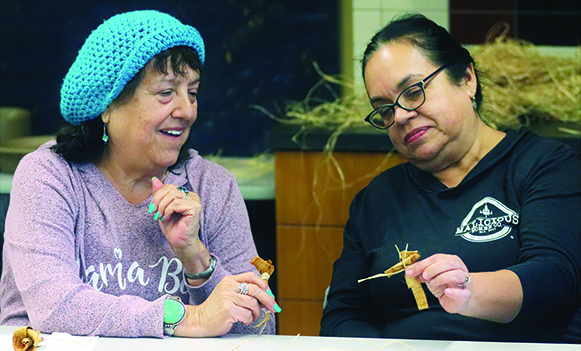
Indigenous Beginnings shares traditional teachings across multiple generations
By Micheal Rios, Tulalip News
When the Native-led, local nonprofit Indigenous Beginnings launched in July 2021, the mission was simple: to freely give and share traditional teachings through in-person, hands-on cultural workshops taught by inspirational knowledge keepers.
Created by Tulalip Court executive administrative assistant Stephanie Cultee, herself a Nooksack citizen and a dedicated employee of the Tulalip Tribes enterprise since 2008, Indigenous Beginnings has hosted 44 workshops thus far. Each intricately designed workshop is intended to help spread the cultural teachings of Coast Salish tribes, while sharing the diversity of knowledge from Native culture bearers in both urban and reservation-based settings.
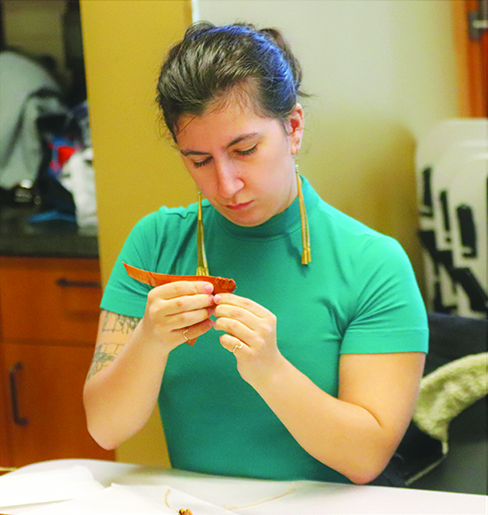
The culturally appropriate nonprofit continues to be dedicated to teaching tribal and nontribal participants how to sustainably harvest, prepare traditional foods, and how to weave, carve and otherwise transform natural resources into utility-filled items. Hosted events have included making delicious jelly from fireweed, harvesting devil’s club and mountain huckleberry, weaving cedar into baskets and headbands, carving canoe paddles, making traditional round drums, and even how to clean, fillet and smoke salmon. Workshops have primarily been led by Tulalip, Nooksack, Lummi and Quinault citizens.
“With Indigenous Beginnings, all of our workshops are for all ages,” explained Stephanie. “There was a whole generation that couldn’t practice or learn their ways from their grandparents because of the boarding school era. So for those older generations who want to learn, they can attend our workshops which is just as much designed for them as any adult or youth. This way we can not only keep our elders involved in their culture, but have them set that example for the young ones that it’s okay to ask questions and admit there’s always more to learn.
“I am from Nooksack and moved down here when I was 15-years-old,” she continued. “I have three daughters who are Tulalip, and I want them to learn their Tulalip heritage and Nooksack’s as well because they are descendants from Nooksack, too. I didn’t know much about my tribe, because I moved away when I was young, and I thought this could be a way that I could teach them the traditional ways of their people, while also learning myself.”
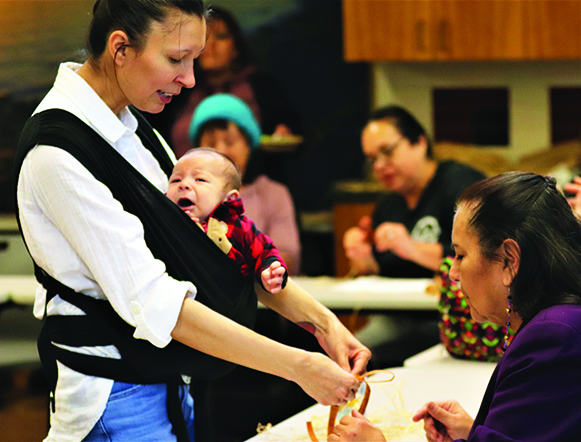
It was in that spirit of cultural understanding and community building that Indigenous Beginnings hosted an awe-inspiring workshop at the Hibulb Cultural Center centered on created cedar roses. Lushootseed teacher Maria Rios instructed the full classroom in the basics of cedar weaving 101, which included at times having her infant son Enzo harnessed belly side.
The diverse group of eager learners spanned multiple generations. They sat intently as Maria detailed how Coast Salish tribes believe the Creator gave their people cedar as a gift. Cedar was the perfect resource, providing tools, clothes, baskets and carvings in addition to having medicinal and spiritual purposes. After being harvested and stored for future use, the highly sought after golden inner bark is separated into strips and intricately shredded for weaving. The processed bark can then be used as a malleable material, similar to wool and other synthetic fibers, and crafted into baskets, clothing, or, as in this particular case, long-lasting roses.
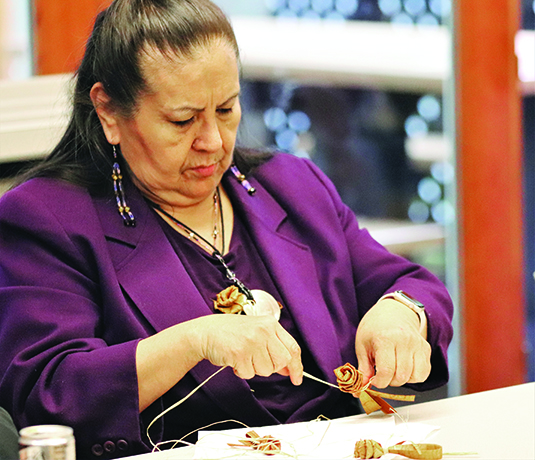
Among the workshop participants was Tulalip mother/daughter duo Carlotta and Cheylah. After receiving a few of the finer weaving pointers from Maria, they quickly found a groove and feverishly created a couple dozen cedar roses. Of course, in the traditional way, Carlotta gave away her first made rose to elder Rebecca Hunter.
“I’ve wanted to relearn how to make cedar roses for a long time now. I was originally taught by the late Tara Taylor over twenty years ago, but unfortunately I lost the teaching by not practicing enough,” shared Carlotta. “My daughter Cheylah is 13-years-old and kind of at the hardheaded phase, so I wasn’t sure if she’d want to come with me or not at first. But then she was so excited to join after I told her Miss Maria was the instructor. I’m so happy we got to participate and learn together. We had a lot of fun.”
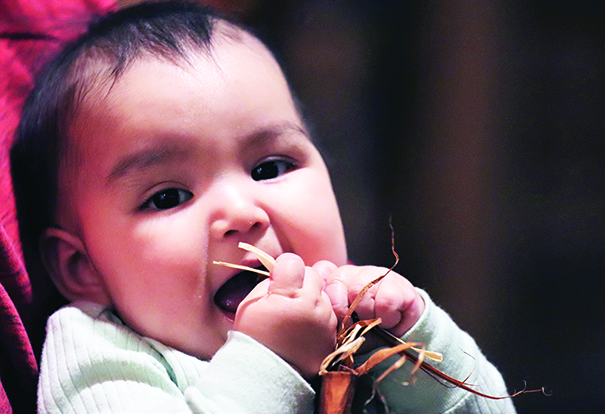
The memorable afternoon was filled with a type of whimsical family bonding that was once common place among tribal villages. With babies, teenagers, adults, and elders all sharing in a unified experience of weaving with yellow cedar. Some for the first time. Others for the first time in a long time. And still others who had only dreamed of one day having the opportunity to create cedar roses in a similar fashion as their ancestors once did.
Such is the case with Seattle resident Shyanne Steele of the Colville Confederated Tribes. She shared having memories of being a little girl and watching her grandma, also a language teacher, weave all kinds of items. When she came across a flyer for the cedar rose workshop on Facebook she jumped at the opportunity at attend.
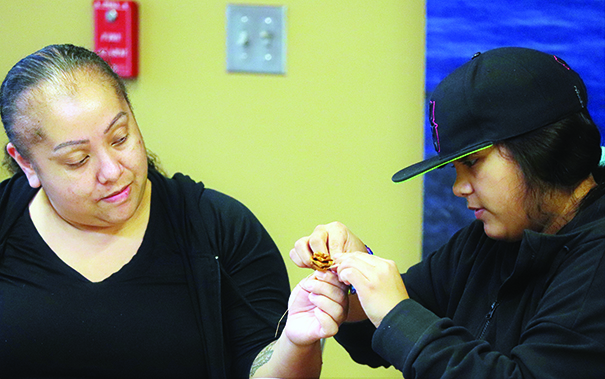
“Lately, I’ve been thinking a lot about how to get more connected with traditional art forms because it’s so difficult for me given my tribe is far away. Then, just a few nights ago, I actually dreamt about harvesting cedar,” said the 24-year-old University of Washington student. “Being able to attend and interact with so many welcoming tribal members here was amazing. It really grounded me to the teachings we have about cedar. Beyond being a super cool and strong material to work with, it’s been central to Indigenous life in this area for countless generations and really helps us connect with our ancestors.”
By bringing tribal citizens of different generations together in an atmosphere of learning and sharing, the Indigenous Beginnings cedar rose workshop allowed participants an opportunity to connect with Natives of neighboring tribes and form meaningful relationships based on shared interests and experiences.
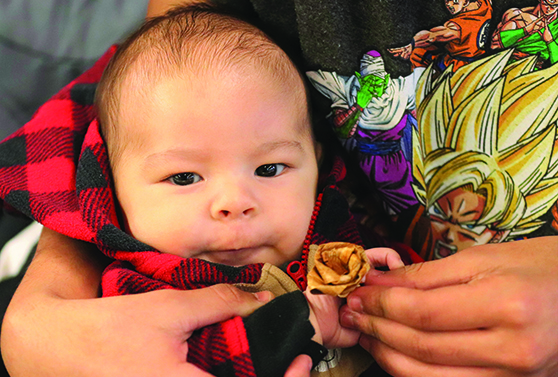
Whether it’s to learn new skills or refine existing ones, the active participation in our shared culture is how we help maintain a strong connection between the past, present, and future. Ensuring that important cultural knowledge and traditional knowhow is preserved and passed on to future generations.